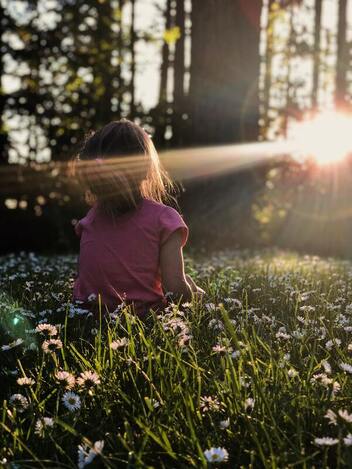 I have a vivid memory of the time I said something that, in the past would take me into a full shame and self-judgment spiral. But that time, there was lightness about it. I couldn't stop laughing at myself. I felt that something was different about me. Unlike previous times, I didn't feel like that moment defined me in any way or that it made me flawed or broken. It was just a funny moment. This moment made me think of other ways in which healing and growth shows up internally.
As we heal, we stop using all of our energy to control situations and to protect ourselves from perceived dangers. And the less we do that, we have more energy (life force) to create and connect to experiences that are light and enjoyable. We understand that our ‘mistakes’ don’t make us less worthy, capable, or lovable. We feel free and see choices that previously weren’t obvious to us. What would you add to this list? Have you noticed any similar shifts in yourself?  You’re not struggling to “be yourself.” You’re struggling because you believe you need to be someone else. Being ourselves becomes difficult when we:
The being part is easy. What’s difficult are the internal pressures and painful stories we tell ourselves. Next time you think you don’t know how to be yourself, notice:
 In moments of clarity, presence, and empowerment, we remember that we want more for ourselves. We don’t force this, it arises naturally. In those moments, we feel connected to a deep self-determination and desire to move forward. We become free from the limitations of our past, even if just for a moment. In those moments, we feel free from shame and self-criticism. We stop defining ourselves by our limitations and instead allow ourselves to see a possibility of all we could be, do, and experience. We are in our true self. When we’re in this place, we support ourselves to dream big, create, be inspired, curious, compassionate, energized, and connected. We may decide that the way we currently live our life doesn’t fit us anymore. Maybe we set big goals and make promises to ourselves. Also naturally, we disconnect from those moments, and go back to our usual ways of living that feel familiar and comfortable, yet constricting. Our conditioned self returns. Maybe it doesn’t yet feel safe to be in the moments of presence and connection for too long. In these moments our conditioned self may tell us that those desires we felt so connected to in one moment, aren’t possible, or that they don’t happen to people like us, or that we are broken, or that we will fail because we failed in the past. Our conditioned self is fearful of change and growth. It wants to bring us back to the state of fear and complacency. That voice may sound like a voice of reason and it may be too loud to ignore. That voice will fight for our limitations and will want us to rebel against the promises we made to ourselves when we felt empowered. In these moments, we have to remind that voice: I’m doing this for me. I’m choosing what supports me. My true desires are coming from self-love. It is safe and healthy to want more. Recently I had an opportunity to be a guest on Next Quest Podcast where I shared about myself, about being a therapist, and how we can grow beyond patterns that restrict our life and limit our growth. I'm sharing some of the main points we discussed in the podcast. As you read through,
see if you can distinguish your patterns and notice in which areas of your life are they prevalent. What are limiting patterns and what are some examples? Limiting patterns are learned adaptations. They are rigid, inflexible, and constricting ways in which we move through the world. These patterns can be reflected in the ways we perceive our personality, in our beliefs, thoughts, triggers, feelings, relationships, actions that constrict our healing and hinder our growth. Patterns that limit us come from a place of childhood wounding and they reflect an automatic reaction based in conditioning rather than a conscious choice based in the present, adult self. These patterns and beliefs run so deep that they feel as if they are unchangeable parts of who we are. Specific examples are: self-judgment, people pleasing, self-sabotaging, self-hatred, self-criticism, blaming, etc. Essentially, patterns can be any internal identifications or behaviors we are attached to that keep us from being grounded in a present and living a life that allows nuance, flexibility, self-compassion, and self-acceptance. How do we develop these sorts of patterns? During a time when we are most vulnerable we have to fit in and adapt to our environment, because as children, we are helpless and depend on those around us for our survival. These adaptations are ingenious, often subtle ways in which we contour ourselves to successfully navigate the family we are born into. We adapt by being highly attuned to our environment and our caregivers, and we figure out what it is that we need to do and who is it that we need to be to successfully navigate our environment. Oftentimes these patterns are a result of chronic misatunement from caregivers, which is a marker of complex trauma, and they affect psychological and biological functioning. They disrupt our natural development and create a distorted sense of self that we take as a truth of who we are. Social and cultural norms play a big role in this as well. Oftentimes we adapt by foreclosing parts of ourselves that somehow feel threatening or unsafe to show, or that are culturally or socially considered unacceptable. In these situations, one may feel compelled to compromise authenticity and true self-expression for safety and acceptance. How do these patterns, in fact, limit us? Patterns subconsciously guide us through life, restrict our authentic expression and prevent us from engaging with life from a place of personal autonomy, responsibility, choice, and awareness. When we operate from these patterns we are responding from a place of a wounded child, not from a place of an adult that has resources and does not have to rely on false, adopted identities in order to move through life. When we are unaware of being driven by these patterns, we tend to rely on rigid, self-imposed “shoulds” to make decisions. Another way in which these patterns limit us is that they get in a way of living life more fully, authentically, with ease, creativity, and peace. They make life more black and white, and prevent us from seeing our humanness in its nuance, curiosity, complexity, and compassion. What can we do outside of therapy or in addition to therapy to grow beyond these patterns? Although therapy can be one of the best ways to deepen our self-exploration and learn how to relate to ourselves with more compassion and self-trust, there are tools and practices we can utilize outside of (or in addition to) therapy. Self-reflection and curiosity will be keys for increasing our awareness and bringing us to a place of choice and embodying resilience. An important note is that self-reflection is not same as analyzing and overthinking; it is different in a way that there is no self-judgment and identifying with the content of our thoughts and feelings, rather, there is a curious observation. Self-reflection is an invitation to turn inwards, tune out the noise, and connect to one’s inner world with an intention to explore. This kind of exploration is based on getting to know oneself on a deeper level without the goal of getting somewhere, evaluating, and comparing. The excitement of it is in allowing ourselves to be surprised by what new parts we might discover about ourselves. If you’d like to begin a guided self-reflection practice, you can take a look at the guided journal I’ve created with the intention of facilitating self-exploration and increasing self-connection. Other ways of doing that is stream of consciousness journaling, where you allow yourself to simply journal about what is on your mind. You can pose yourself questions that will evoke interest and curiosity, and will make you go beyond what you think you already know about yourself. For example: What am I telling myself about this? What am I making this mean about me? What have I not considered yet? Have I chosen to think this away or have I adopted someone else’s view on this? What am I not allowing myself to know? What kind of life feels true to me? What are may values and how can I live by them? I am beyond excited to announce that I have completed a year-long NARM® training (NeuroAffective Relational Model). NARM® is a cutting-edge model for working with attachment, relational, & developmental trauma. This approach works directly with trauma patterns of disconnection that deeply affect our identity, emotions, physiology, behavior, & relationships.
When we start shifting these patterns of self-sabotage, self-hatred, and disconnection, we stop responding to our current circumstances from childhood conditioning. Going through this training was incredibly impactful on a personal and professional level in many ways. I've learned about my own patterns and had some breakthroughs throughout the training (might make a separate post about that). What I most love about it is that it is extremely humanizing, non-pathologizing, and is oriented towards post-traumatic growth. So if you feel called to invest in yourself via depth-focused psychotherapy or personal growth coaching, contact me. My style is rooted in self-inquiry, curiosity, and the human potential and my intention is to create a therapeutic environment that will bring forth a deeper connection to yourself and help you relate to yourself in a curious, compassionate way, leading towards higher self-awareness, self-trust, authentic choices, and personal freedom. This seems like a lot of words, but the bottom line is, you have the capacity to heal, grow, and thrive if you give yourself a chance. |
Categories
All
Archives
June 2024
AuthorSladja Redner |
 RSS Feed
RSS Feed